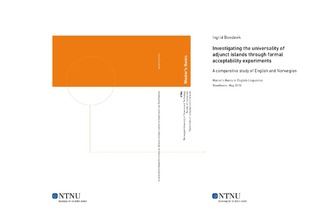| dc.description.abstract | Adjunct islands (i.e., extraction from adjoined clauses) are considered to be islands for movement across languages, and data from English generally serve as good examples of this constraint. Norwegian might provide an interesting point of comparison with English, since preliminary data on Norwegian, gathered both informally and formally, suggest that adjunct clauses in topicalization-dependencies may not be islands (e.g., Engdahl, 1982; Maling and Zaenen, 1982; Faarlund, 1992, Kush et al., in preparation). Considering this difference between languages, investigating patterns of extraction from adjuncts in Norwegian can provide insights into the universal status of adjunct islands.
This thesis investigates whether adjunct clauses are islands in Norwegian. This was experimentally tested with three different complementizer types: om ‘if’, når ‘when’ and fordi ‘because’. Applying the factorial definition of an island effect as seen in e.g., Sprouse et al., (2012a), five different island types were tested in acceptability experiments: subject-island, whether-island, om, når and fordi.
The acceptability experiments provided two main findings: (1) Acceptability of topicalization from an adjunct clause in Norwegian is dependent on the complementizer type heading the adjunct island, providing statistically significant different ratings. Thus, it does not make sense to answer whether “adjunct islands” are islands in Norwegian, as the results suggest that, in relation to island constraints, “adjunct” might not pattern as a natural class. As none of the accounts proposed to explain English “adjunct islands” (and by extension, adjunct islands cross-linguistically) are readily able to explain the effect of complementizer, the findings suggest that that these accounts must be adjusted. (2) There is considerable variation at the participant level within each of the complementizers tested, this is indicative of inconsistent judgements, which none of the current accounts of island constraints are fully able to explain. | nb_NO |
